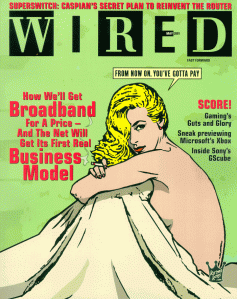Is women’s greatest contribution to technology and/or geekdom their bodies? No, but sometimes it may be hard to assume otherwise.
 On newsstands, December’s cover of Wired magazine is a little hard to miss. Accompanying a piece on tissue engineering is a shot of a woman’s cleavage. Slapped with the cover line, “100% Natural,” it’s a visual (sexual) assault. In a struggling publishing industry, highly sexualized images of women have become so common that we’ve become suspect to otherwise respectable images. But thankfully, we’re hardly subjected to those pesky decent images of women in American media…
On newsstands, December’s cover of Wired magazine is a little hard to miss. Accompanying a piece on tissue engineering is a shot of a woman’s cleavage. Slapped with the cover line, “100% Natural,” it’s a visual (sexual) assault. In a struggling publishing industry, highly sexualized images of women have become so common that we’ve become suspect to otherwise respectable images. But thankfully, we’re hardly subjected to those pesky decent images of women in American media…
Two days ago, Cindy Royal scolded Wired in a blog post that’s been cheered around the Web many times over. An assistant professor at Texas State University, Royal rebuked the magazine for its depiction of women as faceless, person-less beings. “A pair of breasts, no head, no rest of body… just boobs,” she wrote. “Sure it accompanied a story on tissue re-engineering, so what other possible way might you visually represent that, but with a pair of breasts? No other possible way?”
Royal, who teaches web development and journalism, went on to list Wired’s prior offenses – a naked Pam from The Office, LonelyGirl15, sexy manga. Turns out, the faceless breasts were just one sexualization too many. “You’re better than this, she wrote. “You don’t need to treat women in this light to sell magazines. You have the power to influence the ways that women envision their roles with technology. Instead, you’re not helping.” Turns out, it was the first chords of a collective, “We Ain’t Gonna Take It Anymore” Internet sing-a-long voiced via Facebook, Tumblr and Twitter, reinforcing that Royal is certainly not alone in her thoughts.
 The post has since attracted more than 150 commenters, including one that we found a little surprising: Wired editor Chris Anderson, as confirmed by Royal in a post update. In an open response to Royal’s allegations, Anderson argues that cleavage was the only reasonable representation of a story about breasts. “Of all the covers with cleavage out there, it’s hard to find one more editorially justified than that,” he wrote. And while it’s easy to make sense of his logic, Anderson manages to basically skirt the issue of why these “well-known, likable” women who do manage to grace the magazine’s cover are more often than not, half-dressed at best. Instead of admit that he was attempting to market his magazine to men, he balked.
The post has since attracted more than 150 commenters, including one that we found a little surprising: Wired editor Chris Anderson, as confirmed by Royal in a post update. In an open response to Royal’s allegations, Anderson argues that cleavage was the only reasonable representation of a story about breasts. “Of all the covers with cleavage out there, it’s hard to find one more editorially justified than that,” he wrote. And while it’s easy to make sense of his logic, Anderson manages to basically skirt the issue of why these “well-known, likable” women who do manage to grace the magazine’s cover are more often than not, half-dressed at best. Instead of admit that he was attempting to market his magazine to men, he balked.
Nevermind that the magazine has only managed to put a handful of minorities on the cover in its time, it’s almost as if Anderson is blaming women for not being interesting enough to grace the cover of Wired for anything else but a sex gag. (What happened to a good old fashioned apology?) It didn’t sound as if Royal bought the explanation, either. “I just can’t continue to, in good conscience, recommend Wired to my students, when you continue to reinforce the stereotypes that I am trying to refute.” Atta girl.

